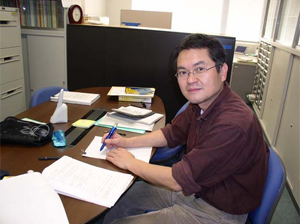- HOME
- Research
Nonequilibrium, nonlinear, ill-posedness, and hierarchyTakashi Suzuki
Main subjects of research
- [1]Analysis and modeling of nonlinear phenomena
- [2]Ill-posed Problem
- [3]Variational Problem
- [4]Mathematical Medicine

[ Objective ]
Problems of basical science(physicas, chemistry, and biology) and applied science(engineering and medicine) have mathematical similarities. At our laboratory, we solve these problems by using mathematical model.
[ Method ]
It is a starting point in mathematical model research to describe actual problems by mathematical equations. We are treating two-directional modelings, top down and bottom up modelings. In the bottom up modeling, one derives mean field equation from micro state. In the top down modeling, on the other hand, one describes equation from macroscopic principles. Many interesting phenomena are observed by simulations of the mathematical equations derived. Then, we start mathematics which dominate these phenomena. Furthermore, we open up our research area by analytical study, revealing depthful principles, such as "quantized blowup mechanism", "cyclic hierarchy", "duality between fields and particles", and so on. Our study also aims to educate undergraduate and graduate students. Training of research staff progresses studies of projects. The current projects are "Nonlinear Technical Science" based on Osaka University School of Engineering and Science and Osaka University, "National Congress of Theoretical and Applied Mechanics", "New Twistof Variational Problem", "Mathematical Medicine", "The East Asia PDE Conference " which PDE researcher at East Asia held, and so on. In this laboratory, there are some foreign students and research fellows through the CREST project "Mathematical Medicine Develops Tumor Growth Explications and Medical Technology Innovations" by JST, and "Marie Curie Action" international research student exchange program.
[ Subject ]
My physical research subjects include self-gravitational fluids (nebulae, stars, plasma), transport phenomena (electrons, chemicals, energy), microscopically-induced ultimate states (superconductivity, superfluidity, condensation, turbulence), microscopic critical states (phase transition, phase separation, hysteresis), tumor formation (inhibition/acceleration, positive/negative feedback, selfness, cell cycle, signal transmission, switching, activation/localization, degrading enzyme, chemotaxis/thigmotaxis, generation/extinction). We conduct mathematical modeling using variational/dissipative structures and mean field theory, and analyze the obtained nonlinear partial differential equations. In these problems, parabolic-elliptic nonlinear partial differential equations with nonlocal terms appear according to the conserved quantities such as mass, temperature, and energy and the mean field level such as adiabatic limit, steady state, and spatial condensation. This idea came from the fact that "collapse quantization" holds in a parabolic-elliptic nonlinear equation system in the study of the process of cellular slime molds condensing to form spores [3]. With the unified analysis method using scaling and dual variational principles, events such as solution blowup/emergence and transitional order formation from the structure of stationary solution sets and the kinetics of particles were proved [1]. Currently, we are producing results in relation to non-equilibrium thermodynamics, gauge theory, and statistical mechanics. The research frontiers are moving toward dissipative structures such as tumorigenesis and chemical kinetics, which do not fall within this framework. Recently we are particularly interested in the Hamilton structure. In contrast, unlike nonlinearity and non-equilibrium, “ill-posedness” is an important theme for engineering research subjects. Methods for causing computers to heuristically search for "desirable solutions" in a world where the solutions are not unique are now fruitful in cooperation with the medical sites. Those methods include "parallel optimization", "ENIDM", and "automated image diagnosis" using computational homology.
[ Basic ]
I wrote books [3,4] about mathematical and numerical analyses. In the first semester, depending on students' backgrounds, we gather materials for their studies, train their foundation for analysis through standard textbooks about mathematical and numerical analyses, select their subjects of studies, and start their studies.
- [0] Principle and Phenomenon: Mathematical Modeling, Baifukan, 2010 (joint authorship).
- [1] Mean Field Theories and Dual Variation, Atlantis Press, Amsterdam-Paris, 2008.
- [2] Lecture on Partial Differential Equation: Introduction to Semi-Linear Elliptic Equation, Baifukan, Tokyo, 2005 (joint authorship).
- [3] Free Energy and Self-Interacting Particles, Birkhauser, Boston, 2005.
- [4] Applied Analysis : Mathematical Methods in Natural Science, Imperior College Press, London, 2004.
- [5] Operator Theory and Numerical Methods, North-Holland, Amsterdam, 2001.
PAGE TOP
